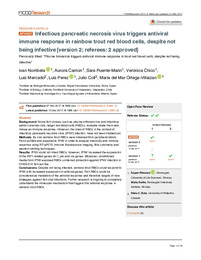Título :
Infectious pancreatic necrosis virus triggers antiviral immune response in rainbow trout red blood cells, despite not being infective[version 2; referees: 2 approved] |
Autor :
Nombela, Ivan 
Carrion, Aurora
Puente Marin, Sara 
CHICO GRAS, VERONICA 
Mercado, Luis 
Pérez, Luis
coll, julio 
Ortega-Villaizan, Maria del Mar  |
Editor :
Taylor and Francis |
Fecha de publicación:
2017-12 |
URI :
https://hdl.handle.net/11000/35039 |
Resumen :
Background Methods : Some fish viruses, such as piscine orthoreovirus and infectious salmon anemia virus, target red blood cells (RBCs), replicate inside them and induce an immune response. However, the roles of RBCs in the context of infectious pancreatic necrosis virus (IPNV) infection have not been studied yet. : Ex vivo rainbow trout RBCs were obtained from peripheral blood, Ficoll purified and exposed to IPNV in order to analyze infectivity and immune response using RT-qPCR, immune fluorescence imaging, flow cytometry and western-blotting techniques. Results : IPNV could not infect RBCs; however, IPNV increased the expression of the INF1-related genes ifn-1 pkr , and mx genes. Moreover, conditioned media from IPNV-exposed RBCs conferred protection against IPNV infection in CHSE-214 fish cell line. Conclusions : Despite not being infected, rainbow trout RBCs could respond to IPNV with increased expression of antiviral genes. Fish RBCs could be considered as mediators of the antiviral response and therefore targets of new strategies against fish viral infections. Further research is ongoing to completely understand the molecular mechanism that triggers this antiviral response in rainbow trout RBCs.
|
Palabras clave/Materias:
erythrocytes
IPNV
birnavirus
immune response
antiviral
trout
interferon |
Área de conocimiento :
CDU: Ciencias aplicadas: Cuestiones generales de las ciencias aplicadas |
Tipo de documento :
info:eu-repo/semantics/article |
Derechos de acceso:
info:eu-repo/semantics/openAccess |
DOI :
https://doi.org/ 10.12688/f1000research.12994.2 |
Publicado en:
F1000Research 2017, 6:1968 Last updated: 21 DEC 2017 |
Aparece en las colecciones:
Instituto de Investigación, Desarrollo e Innovación en Biotecnología Sanitaria de Elche
|
 La licencia se describe como: Atribución-NonComercial-NoDerivada 4.0 Internacional.
La licencia se describe como: Atribución-NonComercial-NoDerivada 4.0 Internacional.
.png)
